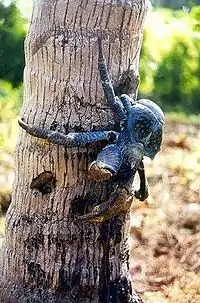椰子蟹
椰子蟹(學名:)又稱八卦蟹,是十足目陸寄居蟹科的节肢动物及無脊椎動物[2]。其體重最高可達6公斤,是現存最大型的陸生甲殼动物。椰子蟹善於爬樹,能爬到樹頂覓食。[3]有人稱椰子蟹為強盜蟹,傳言牠們會從民居和帳篷中偷竊罐和銀器之類的東西,因此椰子蟹在世界上的族群已經愈來愈少了,台灣已將椰子蟹列入臺灣保育物種列表中。
| 椰子蟹 | |
|---|---|
 | |
| 保护状况 | |
| 科学分类 | |
| 界: | 动物界 Animalia |
| 门: | 节肢动物门 Arthropoda |
| 纲: | 软甲纲 Malacostraca |
| 目: | 十足目 Decapoda |
| 科: | 陸寄居蟹科 Coenobitidae |
| 属: | 椰子蟹屬 Birgus Leach, 1816 |
| 种: | 椰子蟹 B. latro |
| 二名法 | |
| Birgus latro Linnaeus,1767 | |
 | |
| 椰子蟹分布地區 | |
特性
牠們是一種寄居蟹,能用螯弄破椰子的外殼,以吃其中的椰子果肉,並因以為其名。
椰子蟹多數出現於熱帶地區海岸與部分亞熱帶群島海岸,通常在日本南方的伊豆群島與琉球群島中可發現到。而台灣如東海岸、綠島、蘭嶼及恆春半島等地分佈最多。另外世界上其他地方如印度洋和太平洋的熱帶島嶼亦有分佈。
喜愛在海中潤濕鰓或繁殖,白天常躲藏於海邊陰涼的樹林、石頭及珊瑚礁之下,晚間才出沒覓食。食地瓜、椰子、木瓜和花生以及動物屍體為食等,但因為人類也會取用椰子來食用的關係,導致椰子的數量缺乏,使得有些椰子蟹因為食物不足而突然開始轉變成獵食者捕殺紅腳鰹鳥、玻里尼西亞鼠和一些小型蟹類。椰子蟹會爬樹,用鰓呼吸。椰子蟹是卵生動物,於海水中孵化。
他們體重最高可達6公斤,是現存最大型的陸生節肢動物。因為善於爬樹,他們可以到樹頂覓食。他們通常會會用鉗子弄破椰子的外殼,以吃其中的椰子果肉。
參考文獻
- Eldredge. . IUCN Red List of Threatened Species. 1996年. [2006年5月12日].
- . 東森新聞. 2015-07-15 [2015-10-16] (中文(繁體)).
- 《中國大百科全書‧26》,北京;上海:中國大百科全書出版社,第二版,26-152頁
書目
- I. W. Brown; D. R. Fielder (编). . ACIAR Monograph 8. Canberra, Australia: Australian Centre for International Agricultural Research. 1991. ISBN 978-1-86320-054-7. Available as PDF: pp. i–x, 1–35 页面存档备份,存于, pp. 36–82, pp. 83–128
- M. M. Drew; S. Harzsch; M. Stensmyr; S. Erland; B. S. Hansson. . Zoologischer Anzeiger. 2010, 249 (1): 45–67. doi:10.1016/j.jcz.2010.03.001.
- Warwick J. Fletcher. . Andrew Wright; Lance Hill (编). . Suva, Fiji: International Centre for Ocean Development. 1993: 643–681. ISBN 978-982-02-0082-1.
- Richard Hartnoll. . Warren W. Burggren; Brian Robert McMahon (编). . Cambridge, United Kingdom: Cambridge University Press. 1988: 6–54. ISBN 978-0-521-30690-4.
- Thomas G. Wolcott. . Warren W. Burggren; Brian Robert McMahon (编). . Cambridge, United Kingdom: Cambridge University Press. 1988: 55–96. ISBN 978-0-521-30690-4.
論文
- Altevogt, R., Davis., T.A. (1975) Birgus latro: India's monstrous crab. A study and an appeal. Bulletin of the Department of Marine Sciences, University of Cochin.
- Barnett, L.K., Emms, C. and Clarke, D. (1999). The coconut or robber crab (Birgus latro) in the Chagos Archipelago and its captive culture at London Zoo, pp. 273–284: in Sheppard, C.R.C. and Seaward, M.R.D. (Eds). Ecology of the Chagos Archipelago. Linnean Society Occasional Publications, 2. Westbury Publishing. pp. 351.
- Combs, C. A. N., Alford, A., Boynton, M. and Henry, R. P (1992). Behavioural regulation of haemolymph osmolarity through selective drinking in land crabs, Birgus latro and Gecarcoidea lalandii. Biol. Bull. 182, 416-.
- Greenaway, P. and Morris, S (1989). Adaptations to a terrestrial existence by the robber crab Birgus latro. III. Nitrogenous excretion. J. Exp. Biol. 143: 333-.
- Greenaway, P., Taylor, H. H. and Morris, S (1990). Adaptations to a terrestrial existence by the robber crab Birgus latro. VI. The role of the excretory system in fluid balance. J. Exp. Biol. 152: 505-.
- Grubb, P. (1971) Ecology of terrestrial decapod crustaceans on Aldabra. Philosophical Transactions of the Royal Society: Biological Sciences. 260: 411–416.
- Held, E.E. (1963) Moulting behaviour of Birgus latro. Nature, 200: 799–800.
- Lavery S Moritz C & Fielder DR (1996) Indo-Pacific population structure and evolutionary history of the Coconut Crab Birgus latro. Mol Ecol 5: 557–570.
- Morris, S., Taylor, H. H. and Greenaway, P (1991). Adaptations to a terrestrial existence in the robber crab Birgus latro L. VII. The branchial chamber and its role in urine reprocessing. J. Exp. Biol. 161: 315-.
- Stensmyr, M. C., Erland S., Hallberg E., Wallén R., Greenaway P., Hansson B. S. (2005). Insect-Like Olfactory Adaptations in the Terrestrial Giant Robber Crab. Current Biology 15: 116–121.
- Taylor, H. H., Greenaway, P. and Morris, S (1993). Adaptations to a terrestrial existence in the robber crab Birgus latro L. VIII. Osmotic and ionic regulation on freshwater and saline drinking regimens. J. Exp. Biol. 179: 93–113(PDF download 页面存档备份,存于)
This article is issued from Wikipedia. The text is licensed under Creative Commons - Attribution - Sharealike. Additional terms may apply for the media files.
